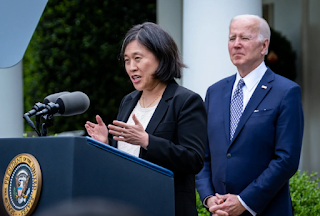"U.S. Reevaluates Climate Trade Deal with Europe Amid Regulatory Differences"
In a collaborative effort to promote environmentally friendly steel and aluminum production to address climate change, the United States and the European Union embarked on a two-year negotiation journey. However, deep-seated disparities regarding the treatment of trade and regulation by governments have surfaced, casting a shadow of uncertainty on the deal. With an approaching October 31 deadline to reach an agreement, the United States has recalibrated its aspirations for the pact's initial iteration.
This shift in ambitions has been met with disappointment by American negotiators, including Katherine Tai, the United States Trade Representative spearheading the discussions. Tai had previously hailed the potential deal as a historic and paradigm-shifting model that could curtail carbon emissions from heavy industries and counter unfair trade competition from countries like China, which has been producing inexpensive steel through methods that are not eco-friendly.
U.S. negotiators originally aimed to establish a coalition of nations committed to cleaner production, commencing with Europe and later expanding to include other countries. This coalition would collectively work to restrict the entry of environmentally unfriendly steel, aluminum, and related products into their markets. Steel and aluminum production is highly carbon-intensive, accounting for roughly 10% of global carbon emissions. However, European objections regarding violations of global trade rules for equitable treatment have complicated this approach.
In response, the Biden administration is now striving to salvage the negotiations by advocating for a narrower deal in the weeks ahead. The revised U.S. proposal entails an immediate agreement for countries to combat the influx of environmentally harmful steel from countries like China. Additionally, it commits to ongoing negotiations in the coming years to develop a framework discouraging trade in products with higher carbon emissions.
These deliberations will feature prominently at an upcoming summit scheduled for October 20, where President Biden is set to meet with Ursula von der Leyen, President of the European Commission, at the White House. The stakes are high, with the potential reimplementation of Trump-era tariffs on European steel and aluminum on January 1 if an agreement is not reached or if a special exemption is not granted.
The talks have confronted a fundamental obstacle: the United States and Europe have divergent approaches to addressing climate change, trade, and competition from China, and neither is yet willing to deviate substantially from their existing policies.
Unlike traditional trade negotiations aimed at global market access, the Biden administration has embraced tariffs, subsidies, and trade agreements that safeguard industries in the United States and allied nations, while restricting the entry of cheaper Chinese products. The European Union has criticized these American measures as protectionist policies threatening international trade rules.
For instance, the European Union is actively pursuing a robust carbon pricing scheme that would tax companies across various industries in Europe and beyond based on their greenhouse gas emissions during manufacturing. European officials have urged the United States to adopt a similar approach, but U.S. officials argue that such a system is impractical domestically, where Congress is unlikely to impose new carbon taxes on American companies.
Moreover, the two entities differ in their approaches to China, the world's largest steel producer, primarily through coal-intensive methods. While American steel manufacturers contend that their Chinese counterparts benefit from generous government subsidies, making Chinese steel available at artificially low prices, European officials have been more cautious about singling out China. Many European nations view China more as a vital business partner than a geopolitical rival.
In light of these complexities, the negotiations have a turbulent history. The Obama administration's efforts to secure a trade deal with Europe ultimately faltered due to irreconcilable disputes over regulation and agriculture. The Trump administration, following trade disputes and tariffs against Europe, attempted a more limited agreement, yielding underwhelming results.
While the Biden administration has mitigated some of these trade disputes, fundamental divergences persist, encompassing the role of government and regulation.
As the October deadline approaches, it remains uncertain whether the talks will result in a comprehensive deal. The outcome is eagerly awaited, especially given the close rapport between President Biden and Ursula von der Leyen, as well as their trade representatives, Katherine Tai and Valdis Dombrovskis. The path to an agreement necessitates concessions from both sides, a challenging proposition due to their disparate priorities.
However, there is optimism that progress can be achieved in the final days and weeks of negotiations, particularly with the upcoming meeting between President Biden and President von der Leyen, which could provide the much-needed momentum to propel the discussions to a successful conclusion.
#ClimateTradeDeal, #EnvironmentalTrade, #USandEU, #ClimateChangeNegotiations, #CarbonEmissions, #TradePolicy, #dambeekeeper, #climatestory, #environmentalstory, #carbonstory

